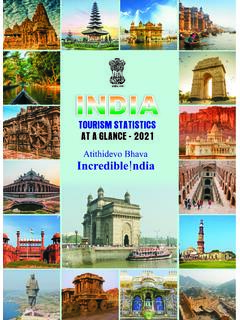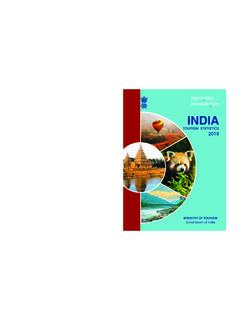Transcription of DEVELOPMENT OF TOURISM IN MALDIVES
1 International Journal of Scientific and Research Publications, Volume 2, Issue 4, April 2012 1. ISSN 2250-3153. DEVELOPMENT OF TOURISM IN MALDIVES . Suresh Kumar Kundur Abstract- TOURISM is the largest sector of the economy in archipelago of the MALDIVES is the main source of attraction to the MALDIVES , as it plays an important role in earning foreign many tourists visiting the country worldwide. exchange revenues and generating employment in the tertiary sector of the country. The archipelago of the MALDIVES is the main source of attraction to many tourists visiting the country. II. THE STUDY AREA. TOURISM began in the MALDIVES in the late 1900's. A United Nations mission on DEVELOPMENT which visited the MALDIVES Islands in the 1960s did not recommend TOURISM , claiming that the islands were not suitable. Ever since the launch of the first resort in MALDIVES in 1972, however, TOURISM in MALDIVES has flourished.
2 TOURISM in MALDIVES started with just two resorts. At present, there are over 80 resorts located in the different atolls constituting the Republic of MALDIVES . Over the past few decades, the number of tourists in MALDIVES has risen continuously. Today, more than 500,000 tourists visit the MALDIVES each year. This paper gives a detailed account of the DEVELOPMENT of TOURISM industry and the initiatives taken by the Maldivian government to promote TOURISM in the country. Index Terms- TOURISM , DEVELOPMENT , Growth, Market share, TOURISM products I. INTRODUCTION. M aldivian archipelago located 500 km from southern tips of both India and Sri lanka . Is a beautiful string of 1,190. low-laying coral islands scattered across the equator in the vast Figure 1: Location Map of Study area expanse of the Indian Ocean, giving us a rare glimpse of what s aptly described as tropical paradise. Just consider this sparkling The MALDIVES archipelago is on the south- south western white sun- kissed beached, crystal-clear lagoons studded with region off the coast of India.
3 The latitudinal extent is 7 06 30 N. profusely coloured corals; azure warm seas with an undisturbed to 00 and longitudinal extent of MALDIVES is 3 15 N and 73 00. exotic marine life palm-fringed island the providing serenity all 41 48 S latitude and 72 32 30 E to 73 45 54 E. of it summarized by the famous Moroccan traveler Ibn Battuta on longitude. describing MALDIVES as one of wonders of the world A series of 1,190 coral islands grouped into 26 atolls located in The sun, the sand and the sea, these are just three simple the Indian Ocean out of which 19 atolls are administrative atolls. realities beckoning tourist from far and wide to these little islets, The MALDIVES has an area of less than 300 square kilometers and giving as a result, a glorious sense of happiness and proving to be a total coastline of 644 kilometers. The islands form a narrow a heavenly getaway from the word and its worries.
4 The MALDIVES chain of 820 kilometers in length and 130 kilometers in width teaches the visitors the pleasurable art of doing nothing, simply within an area of 90,000 square kilometers of ocean. The capital lazing around and enjoying some the most spectacular and city island, Male, is located within Male atoll, which is in the colourful vistas offered by nature. center of the strip of islands that makes up the MALDIVES . The No wonder than that tourists flock in large numbers to the 80- MALDIVES is the smallest country in Asia. odd self-contained island resorts provided with all the comforts Population and warmth exuded by traditional Maldivian hospitality. This is The MALDIVES has a population of 298,968 (in 2006) spread why MALDIVES is considered to be the ultimate destination, the among 196 islands. Strong disparities are evident in the future world for holiday-makers. population distribution between the islands: Male , the capital island, has a population of 102,377, or nearly one-third of the Importance of TOURISM total population, whereas there are 142 islands with fewer than TOURISM is the largest economic industry in the MALDIVES , as it 1000 inhabitants and 76 islands with fewer than 500 persons plays an important role in earning foreign exchange revenues and Only three islands have a population greater than 5000.
5 Hence, generating employment in the tertiary sector of the country. The most of the inhabited islands are sparsely populated while a small International Journal of Scientific and Research Publications, Volume 2, Issue 4, April 2012 2. ISSN 2250-3153. number of islands are heavily congested. The growth of Male is rate in tourist arrivals rose to , with nearly 779651 visitors. a result of migration from the other islands as people seek better The annual average occupancy rate has been from 2001 to job and educational opportunities, and an improved quality of 2010. life. However, this migration has resulted in inequalities both economic and social terms between Male and the other atolls. Table 1: tourist arrival : Annual growth rate (2000-2010). Youth unemployment, increasing crime rate, social disharmony and drug abuse are all outcomes of the highly congested living conditions prevalent in Male and some other islands.
6 The Maldivian age structure is very young with approximately 77%. of the population below the age of 40 years. III. tourist arrival TRENDS. As Figure 1 shows, the main reasons that tourists come to the MALDIVES are for leisure, honeymoon and diving. The majority of tourists (53%) seek leisure and relaxation, but with its strong appeal as a romantic destination, the honeymooner s category (30%) is also significant. The underwater beauty of the islands also attracts divers; they make up 15% of all visitors. Source: MTCA. Monthly international tourist arrivals to the MALDIVES shows the largest tourist source market is Western Europe, the concentration of monthly tourist arrivals occur winter months in Europe. The warmer months in Europe coincide with the months of lower tourist arrivals, which are from May to September. Over the last five years, Europe has been the leading tourist source market to the MALDIVES , contributing an average of more than 76% of the total tourist arrivals.
7 Trends in source markets between 2002 and 2006 are illustrated in Figure 2. Out of the leading source markets, Italy ranked first in 2006. with a share of of the European market. The UK was the Figure 1: Purpose of visit second largest ( ), followed by Germany ( ) then France ( ). Switzerland, Russia and Austria all had much smaller shares ( , and respectively). From Asia, Japan was the largest contributor in 2006 with of market share, followed by China ( ). The market share of Africa was for the same year, while the countries from the region of the Americas contributed and from Oceania only The top ten markets for MALDIVES in 2006 are Italy (25%), United Kingdom (22%), Germany (15%), France (9%), Japan (8%), China (5%), Switzerland (5%), Russia (5%), Korea (3%) and Austria (3%) which is illustrated in Figure 3. Figure 2: tourist arrival Trend tourist arrivals to the MALDIVES have been increasing steadily at an average of 10% per annum over the last ten years, except for the dramatic decline in arrivals during the year 2005 due to the December 2004 Asian tsunami.
8 ( ). The tsunami caused the closure of a number of resorts and tourist arrivals declined by in 2005. The MALDIVES sustained significant economic losses from the tsunami due to the economy s heavy reliance on TOURISM . However, MALDIVES TOURISM has shown remarkable recovery after the tsunami: in 2006 the annual growth International Journal of Scientific and Research Publications, Volume 2, Issue 4, April 2012 3. ISSN 2250-3153. An important highlight of the second phase of TOURISM DEVELOPMENT was The First TOURISM Master Plan (FTMP) which was formulated in 1983. The FTMP laid the foundation for sustainable DEVELOPMENT of TOURISM , emphasized environmental protection and called for integration of TOURISM into the social and economic DEVELOPMENT of the country. Resorts developed during the final years of the second phase followed the FTMP. Policies set out in the FTMP that limit built-up space on resorts, require building heights to be compatible with the natural vegetation of the islands, and include measures for environment and reef protection are still adhered to in resort DEVELOPMENT .
9 Rules introduced during this phase also set the guidelines for the quality of services and facilities provided to tourists. A regulation instigated under the FTMP stated that the built-up area on tourist resorts should not exceed 20% of the total land area of the island. This regulation contributed to the creation of peaceful and quiet environments on resort islands now a key feature of MALDIVES . TOURISM . The third phase of TOURISM DEVELOPMENT , from 1989 to 1997, saw the opening of 16 additional resorts with a further bed capacity of 4920. The positive impacts of the vast developments Figure 3: Market Share in transport and technology experienced in the MALDIVES , and the world over, during the early 1990s were reflected in TOURISM IV. TOURISM DEVELOPMENT DEVELOPMENT during this period. Tourists first started coming to the MALDIVES in significant Thus, apart from growth and expansion of resorts, this was the numbers in 1972 when the first resort, with a 280-bed capacity, phase when innovative and high-quality services were introduced was established.
10 In the years since, five phases can be identified to TOURISM DEVELOPMENT . The Faculty of Hospitality and due to in the DEVELOPMENT of the Maldivian TOURISM industry (MTCA, the fast rate that TOURISM developed, and with a shortage of local 2008a). skilled labour, local manpower alone was unable to cater for the The first phase is considered to be from 1972 to 1978, when demand for jobs created by the TOURISM industry. As a result, TOURISM was largely unplanned and took place according to during this phase a large number of expatriates joined the individual initiative (Dowling, 2000). The 17 resorts with 1300 industry. By the end of 2006, out of the 22,000 jobs in the beds that were established during this time (MTCA, 2008a) were TOURISM sector (MTCA, 2008b) 11,095 jobs were filled by very simple in facilities and modest in services due to a lack of expatriates (MPND, 2007a). This was in spite of a government resources and trained personnel in the field.















